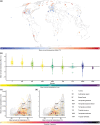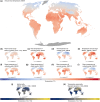Corrigendum
- PMID: 37655678
- PMCID: PMC11062032
- DOI: 10.1111/gcb.16910
Corrigendum
Figures









Erratum for
-
Global maps of soil temperature.Glob Chang Biol. 2022 May;28(9):3110-3144. doi: 10.1111/gcb.16060. Epub 2022 Feb 11. Glob Chang Biol. 2022. PMID: 34967074 Free PMC article.
References
-
- Lembrechts, J. J. , van den Hoogen, J. , Aalto, J. , Ashcroft, M. B. , De Frenne, P. , Kemppinen, J. , Kopecký, M. , Luoto, M. , Maclean, I. M. D. , Crowther, T. W. , Bailey, J. J. , Haesen, S. , Klinges, D. H. , Niittynen, P. , Scheffers, B. R. , Van Meerbeek, K. , Aartsma, P. , Abdalaze, O. , Abedi, M. , … Lenoir, J. (2022). Global maps of soil temperature. Global Change Biology, 28, 3110–3144. 10.1111/gcb.16060 - DOI - PMC - PubMed
Publication types
LinkOut - more resources
Full Text Sources

